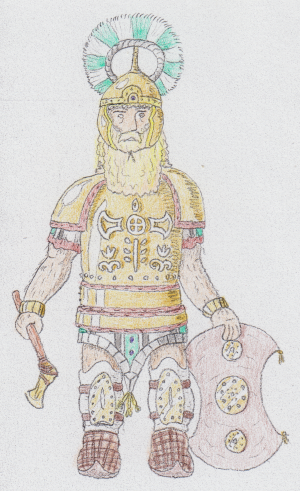Zameltoníans
The zameltoníans1 were ancient dwarven people who founded and ruled Adynía's earliest empire, Zameltonía, during bronze age. The state covered a part the Meldon Plain and western Nemirkía. After the empire's fall, most fled eastwards and were later known as Katargysians, while the Tanikaz-Dwarves are descendants of those who stayed behind.
City-states ruled by tanikaz-dwarves appeared over the next few centuries, the last of which was Þrúdanizía along the lower Kir River. Its fall around 4700 b. Paþ has since been immortalized in tanikazian folklore about the war between the king Þrilúk and the vakkal chief Hakkes.
Non-dwarven natives within the empire formed a lower class, living on farms and villages throughout the region and were only allowed to visit the surface-parts of the cities during the day.
Clothes were commonly adorned with gold embroidery, plaques or buttons, fringes or even precious stones. Dyes were traditionally restricted to minerals, such as ochre, verdigris or crushed precious- or semiprecious stones.
Long hair was favoured by men and women alike, and men often sported long beards. Nobles from different provinces had their own -often very elaborate- local hairstyles, some of which still survive among the fazeronians and Dalindreans of the Zóken Mountains.
The palaces in particular were often decorated with frescoes and bas-reliefs, gold or silver sculptures and colourful tiles.
The combination of enchanted armour and magic staves in war was vital for the zameltoníans; the staves allowed their warriors to use magic without depleting their own arcane energy, and the enchanted equipment to withstand magic attacks which would otherwise overload the glands storing the energy and knock the warriors out.
Not having to use ones own arcane energy was especially important, as when a dwarf is mortally wounded, his body uses whatever arcane reserves it has to heal the wounds; lesser magic means less effective healing and thus reduced chances of survival.
City-states ruled by tanikaz-dwarves appeared over the next few centuries, the last of which was Þrúdanizía along the lower Kir River. Its fall around 4700 b. Paþ has since been immortalized in tanikazian folklore about the war between the king Þrilúk and the vakkal chief Hakkes.
Society
Zameltonían society was highly stratified, with an warrior aristocracy headed by provincial kings remtern, sing. remter), who again answered to a high-king (reremter) at the top, while dwarven commoners formed a middle class of sorts. The latter included all kinds of artisans, smiths and (traditionally) shepherds, all of whom lived within the cities.Non-dwarven natives within the empire formed a lower class, living on farms and villages throughout the region and were only allowed to visit the surface-parts of the cities during the day.
Culture
Apparel
Zameltonían clothing consisted of (usually) woolen tunics for men, woolen dresses for women and sheepskin shoes or sandals for both, not unlike the clothes of modern Halinkazíans or Fazeronians. Trousers were worn during the early days of the empire, though they eventually became mostly restricted to the aristocracy or used during festivals by lower class dwarves.Clothes were commonly adorned with gold embroidery, plaques or buttons, fringes or even precious stones. Dyes were traditionally restricted to minerals, such as ochre, verdigris or crushed precious- or semiprecious stones.
Long hair was favoured by men and women alike, and men often sported long beards. Nobles from different provinces had their own -often very elaborate- local hairstyles, some of which still survive among the fazeronians and Dalindreans of the Zóken Mountains.
Art
Architecture
While zameltonían cities had some structures on the surface, usually homes of dwarven shepherds, artisans and guards around a fortified entrance leading to the underground sections, which formed the majority of the settlements. Down there were the palace, manors of nobles, vast storage areas, workshops and, most importantly, mines and smithies. The ceiling was low and the layout deliberately labyrinthine to deter invaders.The palaces in particular were often decorated with frescoes and bas-reliefs, gold or silver sculptures and colourful tiles.
Cuisine
Zameltían cuisine consisted mostly of wheat, rye, barley, onions and mutton. Common drinks included whey, fermented milk, ale (especially among commoners) and bolról, a mixture of wine and milk.Language
The zameltoníans wrote using hieroglyphs, which later became the basis of most writing systems in central and western Adynía used today.Magic studies
Zameltoníans were the first to mass-produce magic staves, and were pioneers in the use of enchanted weapons and arms in war.Religion
Like the halinkazíans, zameltonían religion was centered around a pantheon of sacred animals, a continuation of archaic totemic deities, whom they worshipped by offering libations, food, and associated metals or stones.Major deities
Deraz
A protective deity, depicted as a dog.Kvazal
Fertility god depicted as a bull, whose worship was adopted from the natives.Neirtó
Mother goddess and patron deity of the zameltoníans, depicted as a she-bear.Úkvó
God of war, depicted as a horse.Warfare
Zameltonían warriors fought using a variety of weapons, such as spears (plix), axes (dirgvezí), sword (remþikazí), bows (ráþek) and arrows (bikál) and, especially when fighting on chariots, magic staves (zóaldází). They managed to keep metallurgy a secret for millennia, giving them a huge advantage against their early enemies, and even after their monopoly ended, Zameltonía's rivals could never quite replicate the quality of their weapons and arms.The combination of enchanted armour and magic staves in war was vital for the zameltoníans; the staves allowed their warriors to use magic without depleting their own arcane energy, and the enchanted equipment to withstand magic attacks which would otherwise overload the glands storing the energy and knock the warriors out.
Not having to use ones own arcane energy was especially important, as when a dwarf is mortally wounded, his body uses whatever arcane reserves it has to heal the wounds; lesser magic means less effective healing and thus reduced chances of survival.
1Original icelandic: Zameltonar, singular: Zameltoni
Parent ethnicities
Diverged ethnicities
Encompassed species
Languages spoken




Comments